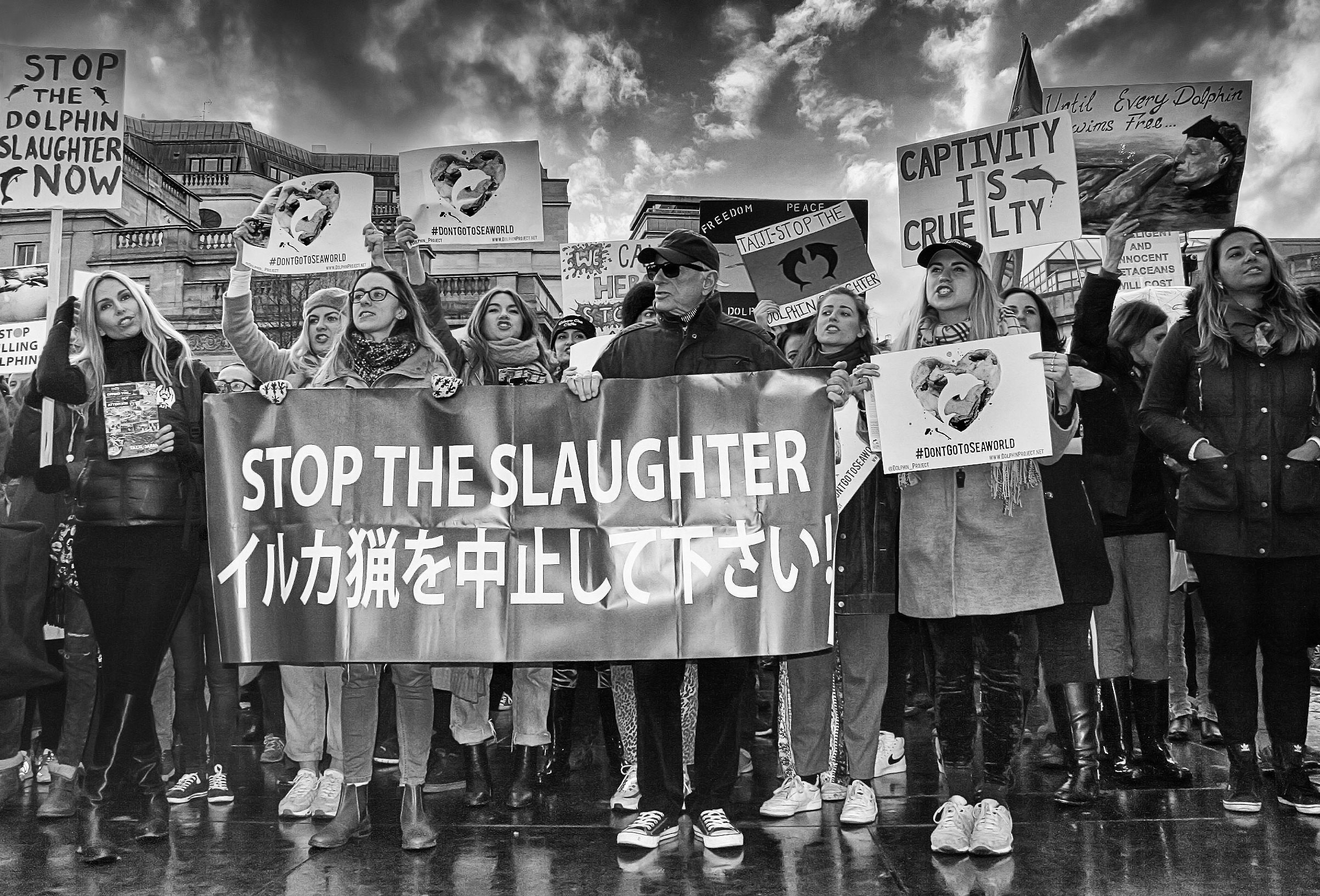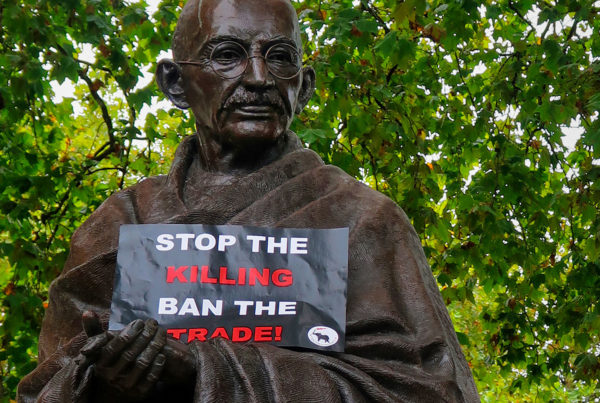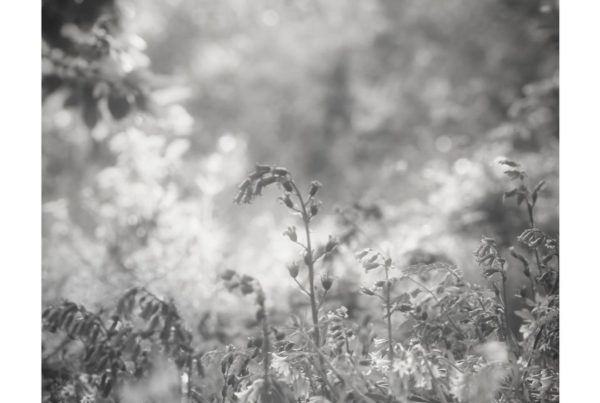Dolphins are highly cognitive. They have complex forms of communication, transmit learning from generation to generation, are self-aware, work cooperatively with each other and other species, and some populations even use tools. Their ability to learn is what condemns them to be captured, bought and sold around the world as they can be “trained” to entertain humans. To confine them and force them to perform for us is cruel. It’s time to end the show and let them be wild and free.
The Hunting Boats
At first light, twelve dolphin hunting boats leave Taiji harbour in search of wild dolphins. The boats fan out beyond the horizon to cover a large expanse of ocean, in order to effectively search well-known migratory routes. Once a pod is found, the dolphin hunters radio each of the other boats, giving their location in order to start the ‘drive’ of the pod into the killing cove. The boat that initially discovered the dolphins remains with the pod until other boats arrive. Once there are five or more boats on the scene, the hunters will initiate the drive.
The boats form a v-shaped wall around the family of dolphins, the dolphin hunters then use a long metal pole attached to the side of each boat, hammering the flanges on top to create a deafening “wall” of sound which terrifies the dolphins. The hunters chase the dolphins toward Taiji Harbour until they have been forced into shallow waters, following the coastline into the Cove. Once successfully driven into the Cove, the dolphins are netted. Hunters arrive in small hand motor-powered skiffs to work side-by-side with dolphin trainers to select dolphins for a life in captivity. The skiffs are also used to force the dolphins onto the rocky shore of the cove, segregate the family pods, and to transport the dead bodies of those slaughtered to the butcher house.
The Killing Process
Entire extended family units – pods – are caught this way. Elders, adults of reproducing age, pregnant females, juveniles and babies are all driven into the cove – multiple generations wiped out in a single hunt.
Once the dolphins are netted within the cove, their fate is sealed. The captive selection and slaughter process commences. Dolphin trainers join the hunters in the shallow waters of the killing cove, selecting individuals – the “prettiest” and “juvenile” dolphins without scars or visible flaws – for the captivity. Here we are shown the direct, bloody link between the mass dolphin killings and the captive industry. Sometimes, the remaining dolphins will be released, but most often, they are all brutally slaughtered for human consumption.
When the Academy Award-winning movie “The Cove” was filmed, the dolphins were killed by spear thrusts. This resulted in a massive amount of blood spilling into the water, turning the cove from a peaceful blue to blood red.
In an effort to reduce the amount of blood spilt into the water and into the sight of the world, the hunters use a killing technique known as “pithing.” A metal rod is pushed into the spinal cord, causing paralysis. Then, a wooden plug is forced into the wound. The dolphins are still conscious, breathing and struggling as they watch their families slowly die.
The dolphins chosen for the entertainment industry are transported via skiff and sling to captive sea pens. The dolphin hunters then tether the flukes of the remaining dolphins in order to control and manoeuvere the dolphins. The panicked animals are then dragged onto the shallow and rocky shore and slaughtered. The dolphins struggle in a pool of their own blood and the blood of their families, slowly suffocating and internally bleeding. On several occasions, dolphins have been seen still struggling as their bodies are tethered to skiffs and dragged to the butcher house. This method of killing is far from humane, despite claims from Taiji Fishermen’s Union and Japanese government officials.
The Captive Industry
The captive industry has become a billion-dollar worldwide trade, with all money made from the exploitation, imprisonment and lifelong suffering of these sentient beings. It is arguable that the dolphin drive hunts would not even take place if it weren’t for the amount of money made from the lucrative sales of live dolphins. The dolphin drive hunts itself as an operation is expensive. The dolphin hunters make approximately $32,000 USD for each live dolphin they capture. These figures can skyrocket from $32,000 USD up to $250,000 USD for a trained captive dolphin.
The captive dolphin entertainment industry and the dolphin drive hunt in Taiji are directly and inextricably linked. Buy a ticket to a marine park and you are supporting the slaughter of these innocent, sentient beings. Supporting a live dolphin show or participating in a confined swim-with-dolphin program anywhere in the world is the same as killing a dolphin in Taiji.
For the dolphins stolen from their families and sold into captivity, life is beyond unbearable. The dolphins born into a life of captivity exist in prison-like conditions and never know their ocean.
Sources and credits: Martyn Stewart, Sea Shepherd Cove Guardians and Dolphin Project. Follow: Dolphin Project
JIYU
Jiyu was a crystal clear example of the immense cruelty of capturing dolphins for captivity.
Report by Rosie Kunneke – November 14th, 2011
There was also the very sad day when we located the very sick and depressed dolphin at the Dolphin Base resort who we affectionately named “Jiyu” (freedom). In earlier reports, I reported on this specific dolphin’s depressed behaviour and resulting injections from the trainers. After these, he went into a deep depression, as evident by floating in the furthest corner of the pen and refusing to take any food from the trainers.
As of last week when we were monitoring the dolphin killers killing a pod of Risso’s dolphins, we noticed that the pen Jiyu was in was empty but we eventually located Jiyu two days later in a different pen. He was neurotically spy-hopping non-stop once again and extremely thin.
We immediately issued a call to action to ask people to please contact the Dolphin Base resort and request for Jiyu’s assisted release and qualified veterinary assistance. I went up to the man we suspect is the owner of the resort and politely asked in Japanese to please give Jiyu his freedom. Instead of considering my request, he phoned the police and told them I was causing trouble. The police came rushing to the scene only to find out that I was not causing any trouble. I asked the police to please enforce the Japanese law on the Humane Treatment and Management of Animals that came into effect in 2006. The policeman indicated that I must remember that animal rights in Japan are not as important as in other countries.
About half an hour after the police had left, one of the dolphin killers showed up dressed in a wetsuit which could only mean they were planning to kill Jiyu. The dolphin killer noticed my presence, immediately made a phone call and then left.
The reality of captivity was even evident later in the day when tourists on a tourist boat docked next to the pens. The dolphin trainers had the dolphins in another pen perform a show for the tourists. It was surreal to see the tourists laughing and clapping for the performing dolphins while in a different pen only 20 meters away, the extremely frail Jiyu was spy-hopping non-stop.
I stayed with Jiyu until it was dark. When we returned the next day, there was a dolphin killer at the resort again and sadly, Jiyu was nowhere to be found. We suspect they killed Jiyu either during the night or very early in the morning when they know we are monitoring the dolphin killers.
Jiyu was a crystal clear example of the immense cruelty of capturing and maintaining dolphins in captivity and we need to make sure his death is not in vain. We need to make sure the world is aware of the absolute cruelty of dolphins in captivity. I would like to thank all our dedicated supporters who fought really hard to help Jiyu – it was truly amazing to see the massive reaction.
(c) Cove Guardians
Watch video by Heather Hill


Angel of Taiji
On January 17th 2014 over 250 bottlenose dolphins were ruthlessly driven into ‘The Cove’ in Taiji Japan.
At about 10 am two separate dolphin drives were spotted just over the horizon. The dolphins attempted to escape many times as the hunters rapidly pushed the massive pods toward Taiji. The large family unit also included a rare albino calf, Angel (named as she looked like an angel with fins). She clung to her mother as the hunters pushed section after section of the pod into the cove, netting them off overnight.
Angel was the first one taken into captivity. A prize to attract the paying public. The remaining pod endured three days huddled together in shallow water, as trainers picked out the ‘pretty’ ones suitable for dolphinariums. Approx. 35/40 taken into captivity, 60/70 slaughtered, the remaining mercilessly pushed back out to sea.
There is widespread speculation that Angel’s mother committed suicide. Witnesses documented her repeatedly spy-hopping, looking for her calf, before lowering into the water, never to resurface. Angel, who once swam alongside her mother, now languishes in a cramped pool at Taiji Whale Museum for the entertainment of human’kind’.
Take the pledge to never buy a ticket http://bit.ly/2zlhlgn







